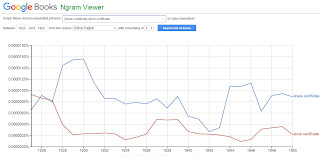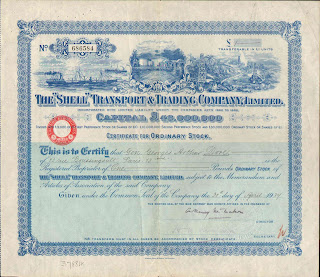Earlier, I explained that "share certificate" and "stock certificate" mean the same. I also believe different kinds of securities have evolved because of changing environments. Well, here is an example of adaptive evolution in scripophily.
Check out the following two certificates :
- double-click their images to enlarge them,
- and look for similarities and differences.
certificate No 1
Image courtesy : Geert Leemeijer
certificate No 2
Image courtesy : Geert Leemeijer
This is an odd couple
Both look like standard certificates. They also resemble each other :
- Both are issued by The "Shell" Transport & Trading Company, Ltd.
- Both are printed by Blades, East & Blades Ltd.
- And both state a capital of £43,000,000.
detail from certificate No 1
detail from certificate No 2
Certificate No 1 was issued almost ten years earlier than certificate No 2. That raises the question why change the lettering from "share" to "stock" ? Why would a company want this : there is no change in the capital structure, and after all stock and share mean the same thing.
A matter of modern language ?
Geert Leemeijer aka Stockold Scripophily brought these two examples under attention in the Collectible Stocks & Bonds Facebook group. Geert suggested that over time the term stock certificate became more popular than share certificate. The different lettering on these securities was ".. a matter of modern language".
Here is an overview of the Shell examples provided by Geert with the date of issue and the stated capital :
- shares
- 1920 - £23,000,000 - 20 ordinary £1 bearer shares , blue
- 1925 - £43,000,000 - 5 ordinary £1 bearer shares, brown
- 1929 - £43,000,000 - ordinary £1 registered shares, blue
- stocks
- 1937 - £43,000,000 - ordinary £1 registered shares, blue
- 1937 - £43,000,000 - 1 ordinary £1 bearer share, red
- 1954 - £88,000,000 - ordinary £1 registered shares, blue
- 1957 - £113,000,000 - ordinary £1 registered shares, blue
Two of these are displayed above, the others are grouped in the paste-up image below. The set illustrates the transition from share to stock for the Shell company.
"Shares" in the upper row, "stocks" below.
The brothers Marcus and Sam Samuel founded The "Shell" Transport and Trading Company in 1897.
Their father imported and sold sea-shells and that's how the "Shell" company got its name.
Their father imported and sold sea-shells and that's how the "Shell" company got its name.
Image courtesy : Geert Leemeijer
Shell is not the only one
Other British companies also favoured stocks above shares. The UK section of Tabak-Peter shows the following examples :
- British-American Tobacco Ltd
- The Imperial Tobacco Company (of Great Britain and Ireland) Ltd.
Another example is the J. Lyons & Company Ltd. J. Lyons started as a spin off from the Salmon & Gluckstein tobacco company at the end of the 19th century. The company expanded into a chain of teashops, ran high class restaurants and started to manufacture biscuits and later ice cream.
J. Lyons & Company, Limited
7% Preference "shares" of £1, 1923
The red stamp on the certificate, see below, tells us that
The Shares referred to herein were converted into stock on the 24th June, 1940
J. Lyons developed original ideas about what the future of business could be like. After World War II they supported the EDSAC computing project at the University of Cambridge Mathematical Laboratory. In 1959 J. Lyons built their own computer, called Lyons Electronic Office I. Based on the EDSAC design, LEO I handled the company's accounts and logistics.
J. Lyons & Company Limited
7% Cumulative Preference "stocks" of £1, 1958
PS : Former British Prime Minister Margaret Thatcher worked
as a food research chemist for the company around the 1950s.
Google's Ngram viewer displays charts that show how often terms, or phrases, occur in a corpus of books over a preselected number of years. The Y-axis shows the percentages of references to each term from all terms Google has indexed for a year (X-axis) in the entire corpus.
 |
| Google Ngram viewer shows a decline for the term share certificate from the 1930s till the early 1940s. double-click image to enlarge |
The corpus used in the chart is British English. It consists of books in the English language published in Great Britain. The chart illustrates a decline for the term share certificate over a period from the 1930s till the early 1940s (blue line). Meanwhile stock certificate saw an increase at the end of the 1930s. You can also check the same with the American English corpus, but the share certificate pattern is not repeated in that graph. According to Google Ngram's data, the term share certificate became more popular again from the 1960s.
Apparently during the 1930s it was trendy to speak of stock certificates in the UK. In this period a number of British companies preferred to market their securities as stock certificates instead of share certificates. Possibly this can be explained by the increase of intercontinental (American) aviation, radio, and film. A matter of adapting modern language.
F.L.
Related links










